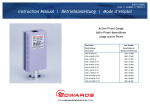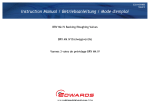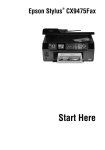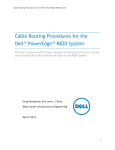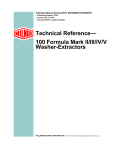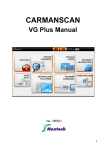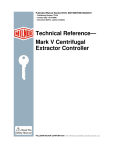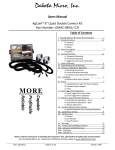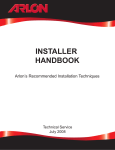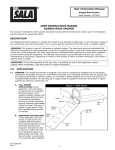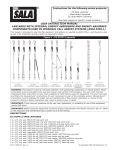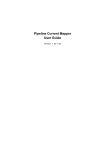Download C KNAPMAN RAILOK - Stone Technical Services
Transcript
9000371 ISSUE F PAGE I Date of Issue: July 2003 ® RAILOK ® RIGID VERTICAL SAFETY SYSTEM INSTALLATION & SERVICING INSTRUCTION MANUAL SALA GROUP UK OLD MILL ROAD, PORTISHEAD, BRISTOL BS20 7BX, UNITED KINGDOM TEL: +44 (0)1275 846119 FAX: +44 (0)1275 849114 email: [email protected] AUSTRALIA Sala Group pty Ltd, 20 Fariola Street, Silverwater, Sydney NSW 2128, Australia Tel: +61 29748 0335 Fax: +61 29748 0336 email: [email protected] GERMANY Sala Group GmbH Flutstrasse 63, D-47533 Kleve, Germany Tel: +49 2821 75330 Fax: +49 2821 753320 email: [email protected] HONG KONG Sala Group Ltd, Room 1001, 10/F, Qualipak Tower, 122 Connaught Road West, Hong Kong Tel: +852 2992 0381 Fax: +852 2858 8163 email: [email protected] 9000371 ISSUE E PAGE II CONTENTS Page Abbreviations ......................................................................... II Safety ..................................................................................... III Description ............................................................................. IV Operation ............................................................................... V Specifications ........................................................................ VI Installation Ladder Rung Mounting .................................................... VIII Ladder Stringer Mounting ................................................. X Top Support Post .............................................................. XIII Maintenance and Inspection .................................................. XV User Instructions .................................................................... XVII Amendment Record ..............................................................XVIII ABBREVIATIONS CEN EDU kg kN Central European Norm Energy Dissipating Unit kilogramme(s) kilonewton(s) m mm Nm RVSS metre(s) millimetre(s) Newton metre(s) Rigid Vertical Safety System CE Approved to BS EN 353-1 1993 Railok is a registered trade mark of Sala Group Ltd. © 2002 9000371 ISSUE E SAFETY - READ THIS SECTION FIRST ! PLEASE ENSURE THAT YOU HAVE THE LATEST EDITION OF THIS DOCUMENT BEFORE USE - IF IN DOUBT CONTACT SALA GROUP LTD. 1. PROCEDURES To prevent personal injury or damage to the RVSS it is essential to read, understand and comply with the procedures in this manual. 2. INSTALLATION Only components supplied by Sala Group Ltd may be used when installing the system. THE RAILOK TROLLEY, RAIL AND ALL ASSOCIATED PARTS ARE FULLY CERTIFIED TO BS EN 353/1 1993. UNDER NO CIRCUMSTANCES MUST ANY PART BE ALTERED, MODIFIED OR DISMANTLED (BEYOND THAT DESCRIBED IN THIS MANUAL) SUCH ALTERATION, MODIFICATION OR DISMANTLING WILL CONTRAVENE THE ABOVE CERTIFICATE AND COULD RESULT IN SEVERE OR FATAL INJURY. 3. SAFE WORKING Observe safe working practice when installing the system. Wear adequate protective clothing - including gloves, goggles, and safety boots. Ensure that tools and equipment used are suitable and adequate. When working at height whilst installing the system use a separate means of fall arrest protection. 4. LIMITATIONS OF USE There is no limit to the number of users on the system at any one time, however only ONE person, whose weight must not exceed 136kg, may be attached to each EDU and only ONE trolley may operate on each individual 3m length of rail at any one time. PAGE III 9000371 ISSUE E PAGE IV DESCRIPTION The RVSS is designed to prevent falls from fixed ladders or structures to which it is attached. It is comprised of two main elements : a rail, permanently attached to the ladder or structure and a trolley which runs on the rail (see fig 1). In the free-running, unlocked position the outer ends of the arms of the trolley are inclined upwards at an angle of approximately 10o and only the rollers are in contact with the rail (see fig 2). If the arms fall below this position and reach the horizontal the brake pads come into contact with the front face of the rail and lock the trolley (see fig 2). It is a CEN requirement that, in order to reduce the adverse physical effects resulting from fall arrest, a shock absorber is incorporated into the system which ensures that the maximum force exerted on the body does not exceed 6kN. Therefore an Energy Dissipating Unit (EDU), to which the user is attached by means of a selflocking hook, is fitted to the trolley. There are no user serviceable or adjustable parts on the trolley. Railok Systems supplied prior to the introduction of the EDU should be upgraded by returning the trolley to Sala Group Ltd. for the fitting of an EDU. Each fixing point on the ladder or structure to which Railok is fitted must be capable of withstanding a minimum loading of 4kN. The complete structure must be capable of withstanding a load of 12kN per simultaneous user. Trolley Rail Energy Dissipating Unit Automatic Self-locking Hook Unlocked Position FIGURE 1 FIGURE 2 Locked Position 9000371 ISSUE E PAGE V OPERATION The lower extremity of the fixed rail terminates approximately 0.5m above ground level. With the arrow engraved on the outer face of the trolley pointing ‘UP’ the trolley is positioned on the rail and raised to the height required to enable the user to attach the self-locking hook on the EDU to the front ‘D’ ring of a full body harness. The ladder may then be climbed normally. If it is necessary to stop at any point on the ladder the trolley must be raised as high as possible above the user and allowed to lock on the rail. The risk of free fall is thus eliminated. A stop plate assembly, shown in figure 4, may be fitted to the upper and lower extremities of the rail to prevent removal of the trolley from the system. This is particularly important where a hazard exists at the top or bottom of the ladder system. Where it is required to be detached from the system at the top of a ladder the upper extremity of the fixed rail can extend 1.3m above its top attachment point on the ladder but must not be unsupported. The user detaches himself from the trolley within this length and the trolley either remains in position for subsequent descent or is taken to the next rail installation for continued ascent. A stop bolt, shown in fig 3, may be fitted to the upper and lower extremities of the rail to prevent unintentional removal of the trolley from the system. To detach the trolley, if stop bolts are fitted, the user grips the nut (1) and depresses the stop bolt (2) to allow the trolley to be removed. The user must not be detached from the Railok system unless in a safe area or connected to an alternative safety system. FIGURE 3 FIGURE 4 9000371 ISSUE E PAGE VI SPECIFICATION (FIGURE 5) PART NO. 1. P-1051 RAIL, Extruded Aluminium. HE30TF 2. P-1051-S RAIL, Stainless Steel. Recommended for maritime or corrosive conditions. 3. P-1059 JOINT PLATE, PLAIN, Aluminium HE30TF JOINT PLATE, THREADED, Aluminium HE30TF 4. P-1059-8-25 BOLT, JOINT PLATE, M8 X 25, Stainless Steel, Grade 316A4 to BS5845/1991 5. P-1055-X CLIP, RUNG, Anodised Aluminium HE30TB (‘X’ suffix denotes rung diameter in mm) 6. P-1054-X CLIP, ‘J’ RUNG, Anodised Aluminium HE30TB (‘X’ suffix denotes rung diameter in mm) 7. P-1053-X CLIPS, ANGLE (pair) Anodised Aluminium HE30TB (‘X’ suffix denotes angle size) 8. P-1052-X-Y CLIP, STRINGER, Anodised Aluminium HE30TB (‘X’ suffix denotes stringer width, ‘Y’ suffix denotes stringer thickness) 9. P-1061 CLIP, STRINGER, Mild Steel, BS4360: 1986 43A, galvanised to BS729 10. P-1058-X SPACER, CLIPS, Anodised Aluminium HE30TF (‘X’ suffix denotes spacer length in mm) 11. P-1056-X BOLT, RAIL FIXING, M10, Stainless Steel, Grade 316A4 to BS6105/1981 (‘X’ suffix denotes bolt length in mm) 12. P-1057-10 LOCKNUT, M10, Stainless Steel, Grade 316A4 to BS6105/1981 13. P-1060 WASHER, Neoprene (for use in conditions where high corrosion risk is present) 14. R-1050/Z/3465 TROLLEY, Complete with Energy Dissipating Unit (part no. N-ED1) and selflocking hook. Each trolley is serial numbered and date stamped and a certificate of conformity is supplied with the User Instructions. 15. P-1064 ASSEMBLY, STOP BOLT, Spring loaded. 16. C3000552 POST, Top Support. 17. B4000444 ASSEMBLY, STOP PLATE. 18. 3000713 Top Reinforcement NOTE: For installation purposes the weight of a 3m length of aluminium rail with its attaching parts is approximately 4kg. For a stainless steel rail the weight is approximately 8kg. Special fittings to suit applications not covered by the standard attaching parts can be supplied. Please contact Sala Group Ltd for further information. 9000371 Rail Dimensions (mm) A - 3048 B - 305 C - 1524 D - 2743 E - 93.5 ISSUE E PAGE VII 2.4m long aluminium extrusion 18 Top Support Post Dimensions (mm) A - 1930 B - 275 C - 430 FIGURE 5 16 9000371 ISSUE E PAGE VIII INSTALLATION The adaptability of the means of attaching the RVSS rail ensures that the system has a wide range of applications the most common being fixed ladders and lattice towers. Before installation care must be taken to determine the most suitable position in which the rail is to be fitted. When used with a fixed ladder the rail is attached to the rungs or stringers (i.e. the vertical side members). If the rail is to be rung mounted it must be ascertained that, if positioned on the ladder centre line, adequate clearance exists on each side of the rail for the safe positioning of the user’s feet on the rungs. If this cannot be achieved the rail must be off-set to one side or, alternatively, stringer mounted. On lattice towers either the legs or the struts may be used for fixing and similar care regarding rail positioning should be taken. The correct and safe operation of the RVSS depends on the satisfactory installation of the rail sections. Such an installation will have rail sections that are not twisted and joints correctly fitted so that the trolley moves smoothly over the entire length of the rail. The following examples are for ladder rung attachment and ladder stringer attachment. Standard attachment parts are used and individual installations may differ from those illustrated. Ladder Rung Mounting Rail Attachment Figure 6 shows the first attachment point of the rail to a ladder rung using a standard rung clip or, as an alternative, a ‘J’ rung clip. There are three groups of attachment points along a 3m section of rail, each having four slotted holes. One hole in each group must be used for attachment and each attachment point dealt with in ascending sequence. The hole selected must be that most suitably positioned relative to the clip on the rung. Ensure that if using the neoprene washer it is placed on the fixing bolt with its radiussed outer edge towards the rail and that before tightening the locknut the head of the fixing bolt is recessed into the central channel of the rail as shown in detail ‘A’. Rail fixings must be tightened to a torque of 45 Nm. In exceptional circumstances where it proves impossible to use an existing attachment point an 11mm hole may be drilled on the rail centre line. However, the approval of Sala Group Ltd must be sought before such action is taken. When the first section of the rail is securely attached the installer may use the trolley as the ladder is climbed. However the trolley must not pass beyond the rail joint until the joint plates are securely fitted and the first attachment point of the next rail is securely attached. WARNING If the RVSS is used in conditions where high ambient temperatures occur, that is in excess of 20oC, it is important that the rail fixing bolts are centrally positioned in the slotted fixing holes. If, after installation in such conditions the rail shows signs of buckling due to misalignment the fixing bolts should be slackened and the rail reset. The fixing bolts must then be retightened. The trolley must not be used during this operation and an alternative means of protection from falls be employed. Rail Joint Figure 7 shows a typical rail joint. The joint plates must be attached to the lower rail section and the two fixing bolts finger tightened. The next rail section is then slotted between the upward projecting joint plates and the remaining two bolts fitted. To accommodate the widest temperature range in which the RVSS may be used it is essential that a gap exists between adjoining rail sections to allow for rail expansion. To set this gap pull the upper rail upwards as far as possible before tightening the four joint plate bolts to 25Nm. WARNING Where a ladder stops at a platform the rail must not extend above platform level without support and the last attachment point of the rail to the ladder must be as near to the top of the ladder as possible. WARNING ® Sala Railok is designed and manufactured by Sala Group Limited to meet the relevant EN specifications for rigid vertical safety systems and carries CE approval. However Sala Group Limited cannot be held responsible for the integrity of the structure to which the system is attached. The installer should satisfy himself/herself that the ladder and the mounting points or structure to which the system is attached is capable of withstanding the transferred loads which may be applied in the event of a fall arrest. 9000371 ISSUE E PAGE IX P-1051 20mm diam. rung P-1055-20 P-1057-10 P-1054-20 P-1058-25 P-1057-10 P-1056-75 0.5m Minimum P-1056-40 P-1057-10 P-1051 Detail ‘A’ P-1060 (if required) P-1058-25 P-1056-50 FIGURE 6 P-1051 Gap to be maximum obtainable P-1059-8-25 P-1059 (Threaded) P-1051 P-1059 (Plain) FIGURE 7 9000371 ISSUE E PAGE X Stop Bolt Assembly Installation Stop Plate Assembly Installation The stop bolt assembly is fitted to the rail as shown in figure 8. Tighten the nut on the attachment bolt (1) to 45Nm. Adjust the position of nut (2) on stop bolt (3) to obtain the dimension shown. Fit locknut (4) so that at least one full thread (5) is exposed when locked against nut (2). If the top of the installation does not terminate at the end of a complete section of rail it will be necessary to drill two 11mm diameter holes. Use the joint plate (6) as a template for hole positioning aligning the end of the joint plate with the end of the rail. The stop plate assembly is fitted to the rail (as shown in figure 9) using the existing joint plate holes drilled in the rail. If the top of the intallation does not terminate at the end of a complete rail section it will be necessary to drill two 11mm diameter holes. Use the spacer as a template for the hole positions. Tighten the fixings to 25Nm. Stop Plate Spacer 22-23mm View on arrow View on arrow FIGURE 8 Ladder Stringer Mounting Rail Attachment The three alternative standard methods of attachment are shown in figure 10. On assembly ensure that the stringer clips are a snug fit. For further assembly instructions refer to Ladder Rung Mounting. Rail Joint Refer to Rail Joint in Ladder Rung Mounting. FIGURE 9 9000371 FIGURE 10 ISSUE E PAGE XI 9000371 ISSUE E PAGE XII RAILOK TOP SUPPORT POST & TOP REINFORCEMENT Where a ladder stops at a platform or roof level the Railok system must not extend above its last attachment point. However, if it is required to extend the rail beyond that attachment point Sala Group Ltd can supply a support post to enable the rail to extend as much as 1.3m above the platform or roof level. The post may be fitted to either a rung or stringer mounted Railok system. The Top reinforcement extrusion takes the place of the 25mm spacers, which must be discarded. Excess material below the second mounting point can be trimmed off if desired. Alternatively if the extension is limited to a maximum of 700mm an economical extruded top reinforcement is available which can also be easily retrofitted to existing installations. Top Reinforcement Installation The Top Reinforcement is supplied in 2.4m lengths, to be drilled on site as required. It is shown in cross section below. When retrofitting to existing installations the locknuts must be replaced with new ones. The Top Reinforcement can be fitted to Rung mounted or stringer mounted installations. Two 10mm diameter holes are pre-drilled at top of the extrusion to accept the end stop bolts which will need to be 25mm longer than the standard bolts. The extrusion must then be drilled to coincide with the top two mounting points. The topmost mounting point must be no more than 700mm from the top of the rail and the top reinforcement. Max.700mm If the Top Reinforcement crosses a joint plate, the extrusion should be drilled to accept the joint plate bolts. The existing joint plate bolts should be discarded. New longer bolts should be fitted through the front joint plate and screwed into the threaded back joint plate re-fitted at the back of the top reinforcement extrusion. 9000371 ISSUE E PAGE XIII RAILOK TOP SUPPORT POST RUNG MOUNTING Where a ladder stops at a platform or roof level the Railok system must not extend above its last attachment point. However, if it is required to extend the rail beyond that attachment point Sala Group Ltd can supply a support post to enable the rail to extend as much as 1.3m above the platform or roof level or a Top Reinforcement to extend up to 700mm. These parts may be fitted to either a rung or stringer mounted Railok system. It is critical that, when attaching the support post to the ladder rungs, the upper of the 3 attachment flanges must be attached to the first rung BELOW platform or roof level, see figure 11. One of the 3 bolts securing the post to the rungs must also secure the rail. A typical post/rail to rung installation is shown in figure 12. Three alternative holes are provided in each of the 3 pairs of flanges to accommodate a range of rung pitch. Check that the post is vertical before tightening the fixings to 45 Nm. SUPPORT POST INSTALLATION CAUTION The support post weighs 12 kg and MUST be secured safely whilst being installed. WARNING When attaching the Railok rail to the post a minimum of 2 fixing bolts must attach it over the length of the post. The sizes of the post fixings, i.e. bolts, spacers and clips, will be dependent on the ladder rung and stringer dimensions. The installer should calculate the sizes required prior to ordering components from Sala Group Ltd. Highest permissible attachment rung Top support post FIGURE 12 FIGURE 11 9000371 ISSUE E PAGE XIV Platform level Attach post below this rung FIGURE 13 STRINGER MOUNTING It is critical that when attaching the support post to the ladder stringer the upper of the 3 attachment flanges must be positioned under the first rung BELOW the roof or platform level, see figure 13. One of the bolts securing the post to the stringer MUST also secure the rail. A typical post/rail to stringer installation is shown in figure 14. Three alternative holes are provided in each of the pairs of flanges to accommodate a range of stringer thicknesses. Select the hole in the flange so that the fixing bolt is as close as possible to the stringer. Tighten fixings to 45 Nm. RAIL TO LADDER) POST ATTACHMENT FIGURE 14 Flange 'A' (ABOVE The rail extending above the ladder must be attached to a minimum of one of the upper 3 flanges. The optimum attachment point is flange 'A' as shown in figure 15. If this flange is used the rail must not extend beyond the top of the post. If flange 'B' or 'C' is used for attachment the rail must not extend above the last attachment flange. Tighten rail fixings to 45 Nm. Flange 'B' Flange 'C' FIGURE 15 9000371 ISSUE E PAGE XV MAINTENANCE Pre-Use Checks RAIL - Including joints and attachments. Check that there is no corrosion on the rail and its joints which may impair the smooth running of the trolley. Check that all joints are secure and that neither the joints or the rail are d i s t o r t e d . This check cannot be made over the entire length of the rail without climbing the ladder or structure, therefore check the entire length of the rail during initial ascent. TROLLEY Check that there is no corrosion which may impair operation. Ensure that all fastenings are secure and that the rollers rotate freely. Check that there are no cracks, splits, bends or distortion of any element of the trolley. Ensure that trolley ‘hinges’ to and fro with light spring assistance. NOTE: Under normal operating conditions no lubrication is required on the rail, however where ice may form on the rail a protective coating may be applied to the rail to prevent such formation. In these circumstances ensure that, after use, the trolley is thoroughly cleaned, particular attention being give to the free rotation of the rollers. Annually (Normal operating conditions) Six Monthly (Maritime/corrosive conditions or in conditions of intensive use) RAIL 1. Remove all environmental deposits (especially salt encrustation) with a fibre (NOT wire) brush or "Scotchbrite". 2. Ensure that all fixing clips are in place and their fixings secure. 3. Check each rail to rail joint for security. 4. Check for localised or more extensive distortion.If distortion is evident it is indicative that the rail may have been subjected to a fall arrest load. In this event rail that rail and those immediately adjoining it together with associated joint plates and rail attaching parts MUST be replaced. If the distortion is on a joint the rails on either side of that joint, the joint plates and the rail attaching parts MUST be replaced. 5. Check that there are no cracks, splits or corrosion on the rail, its joint plates or the attachments to the ladder or structure. 6. Check stop bolt operation (if fitted). TROLLEY (See fig. 16) 1. Holding the trolley on its side pivot the top plate forward. Release it and ensure that it pivots fully rearwards with light spring assistance. 2. Ensure the four brake ‘discs’ are in place and correctly positioned. 3. Check that all rollers rotate freely. 4. Ensure that the rivets attaching the plates to the upper and lower arms are secure by attempting to pull the arms apart. No movement of the arms is permissible. 5. Check the relative movement between the upper and lower arms. The dimension shown must not exceed 1.5mm. 6. (not illustrated) With the trolley in position on the rail ensure that it will move upward freely when lifted by the EDU snap hookand that it locks on the rail when the hook is released. Ensure that the trolley moves freely over each rail joint. 7. Clean with a cloth and warm soapy water. DO NOT IMMERSE. Lubricate rollers with water repellant oil (e.g. WD40). Wipe off excess oil. 8. Check that the EDU ‘D’ ring locknuts are secure. 9. Check that the EDU ‘D’ ring rubber sleeves are in place and in sound condition. 10. Check that the outer sleeve of EDU is correctly positioned and in good condition and that no webbing has been pulled from the sleeve. 11. Check that the webbing at the ‘D' ring and snap hook is sound. 12. Check the snap hook for corrosion and ensure that the locking mechanism functions correctly. Check that the hook pivots freely on its attachment ring. 13. (not illustrated) Proof loading must be carried out by Sala Group Ltd to 6.67 kN (1500 lbs) then repeat steps 1-8. WARNING If the trolley sustains a fall arrest it MUST be withdrawn from service immediately, labelled to indicate it is a quarantined component and returned to Sala Group Ltd together with a note indicating the nature and circumstances of the fall. 9000371 ISSUE E PAGE XVI FIGURE 16 9000371 ISSUE E PAGE XVII USER INSTRUCTIONS The following instructions are supplied in twelve European Languages to each RVSS customer and it is the customers’ responsibility to ensure that the intended user reads and understands these instructions. The user must wear a correctly fitted full body harness in order to use this equipment. A. Slide the trolley 1 onto the rail 2 with the arrow 3 pointing UP. Allow trolley to lock on the rail at approximately chest height. B. To open hook safety catch: depress and hold hook lock release 4. Rotate lock 5. Attach hook to harness ‘D’ ring and release safety catch. C. Ascend and descend the ladder in the normal manner. D. If it is necessary to stop on the ladder raise the trolley as high as possible and allow it to lock. E. On disconnecting from the trolley when the top of the ladder is reached the trolley may be left in position on the rail or removed and used for further ascent if required. WARNING Do NOT use any additional connector or lanyard with this equipment. Use only on Railok installed system. 9000371 ISSUE E PAGE XVIII AMENDMENT RECORD DATE TODAY ISSUE No. AMENDED BY (NAME) SIGNATURE 9000371 ISSUE E PAGE XVIV 9000371 ISSUE F PAGE XX ® RAILOK ® RIGID VERTICAL SAFETY SYSTEM Installation Certificate Sala Railok® is designed and manufactured by Sala Group Limited to meet the relevant EN specifications for rigid vertical safety systems and carries CE approval. However Sala Group Limited cannot be held responsible for the integrity of the structure to which the system is attached. The installer should satisfy himself/herself that the ladder and the mounting points or structure to which the system is attached is capable of withstanding the transferred loads which may be applied in the event of a fall arrest. THIS IS TO CERTIFY That the Railok® system fitted at (location) ..……………………….............................. .............................…………………………………………………………………………… Height of Ladder .............................……………………………………………………….. Rung Fixing / Stringer fixing (delete as necessary) Maximum number of simultaneous users .............................…………………………… Has been installed in accordance with the instructions contained in the Sala Railok® Installation & Service Manual (Sala Doc Ref # 9000371 Issue E) and the integrity of the supporting structure and mounting points as described above has been verified and approved. Installed By (name) .............................……………………………………………………. Company ..............................……………………………………………………………….. Signed ....................……………………………………..Date ...........……………………. A copy of this certificate should be handed to the client on completion of an installation and a photocopy returned to Sala Group Limited.




















